Grand Canyon Speed Record Attempt January 13, 2017
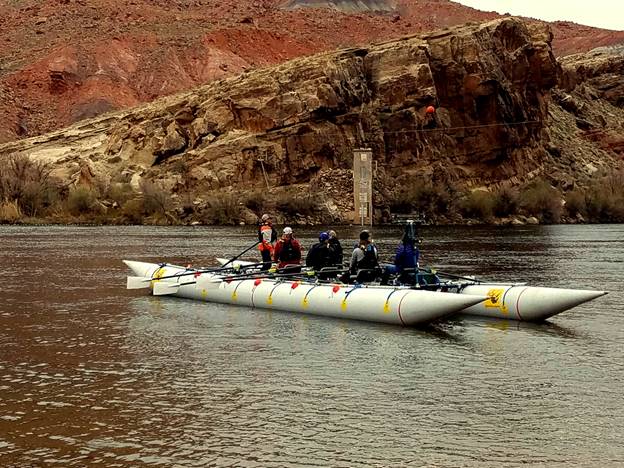
By Jack Kloepfer- Jack’s Plastic Welding
This is the story behind the gear that makes this attempt possible, and some of the adaptations that were used to make this craft faster for this kind of speed record.
I would like to start by saying, it is, and continues to be a huge honor to be a part of the river community. Nowhere on earth is there a happier committed group of people. To be able to participate in this endeavor is one, if not the highest point in my career as a builder and designer of rafting equipment. As I write this, I am reminded by the clock, that if they did not yet have any problems, they should be running Crystal rapid about now.
But this whole thing would not have happened if it were not for a big mistake we made in 2011. At the end of that year, our business had one of its best seasons. We did not want to let any grass grow under our feet, so we took on a new project. This project was called Flight Deck Factory. It was all about making inflatable features that could be set in the snow, or out on the water, that people could launch their kite boards, or skis from, get airborne, and do tricks. We had a partner in this venture, and we worked hard to build inflatable ramps to his specifications. After we had the first set built his part of the business, the marketing part, started to unravel, and even though he tried hard to make these work in a number of ways, after 5 years we recalled all the products to see if there was something else we could make from these inflatable components. Of particular interest was the slider that was made of 3- 40 ft. long tubes 25 inches in diameter. Basically they were placed upside down in a triangle to make a launch ramp for kite boards and kite skiing. They really did work. But we could not sell them, so I wanted them back to see if I could make some shorter cat tubes out of them, and sell them at a discount. In that way I could recoup some of the money we used getting this project going.
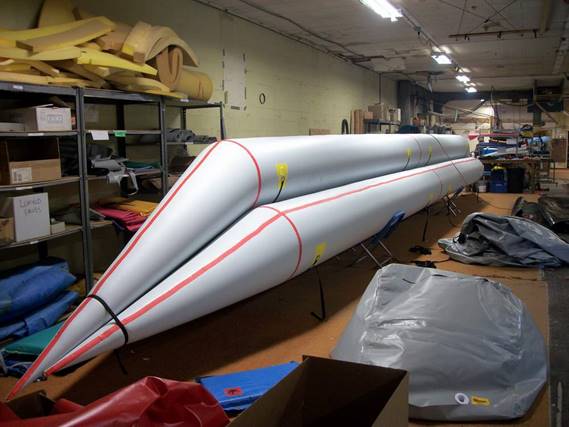
Those tubes were just back in the shop for about a month when I got a call from Seth Mason. I remember the conversation going something like this. Seth Said, “We were trying to get an extra-long cataraft from SOTAR, but they are way too busy to pull it off, and we need something right away so we can start training to beat the Grand Canyon Speed record”. That is when I said to Seth, “I think I have just the right set of tubes”. In fact I do not think they could have been a better design for what they were attempting to do. The only thing was that they may actually be a little too long. But let’s give it a go, and see what happens. I also mentioned that I thought extra flotation from the extra length would justify the longer tubes with more speed.
That night I loaded up the tubes, took them home, and over the weekend, I glued some more D rings on them so they could train with them. Seth had a pretty good idea of how the frame should work, and he started to get that part of the boat together. As well as sculling oars, sliding seats, and lights.
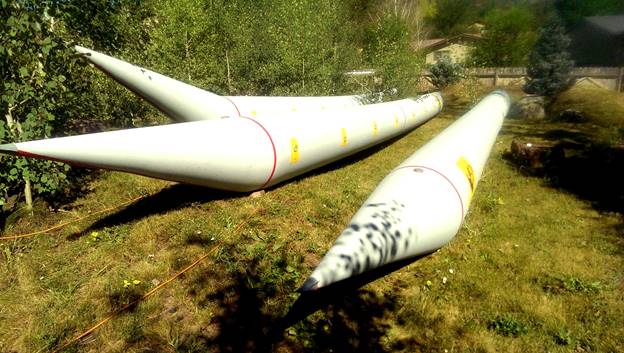
After a few trial runs, one down Cataract Canyon, and one down Westwater, We got the tubes back and added 2 baffles in each tube so they were not single chamber tubes anymore.
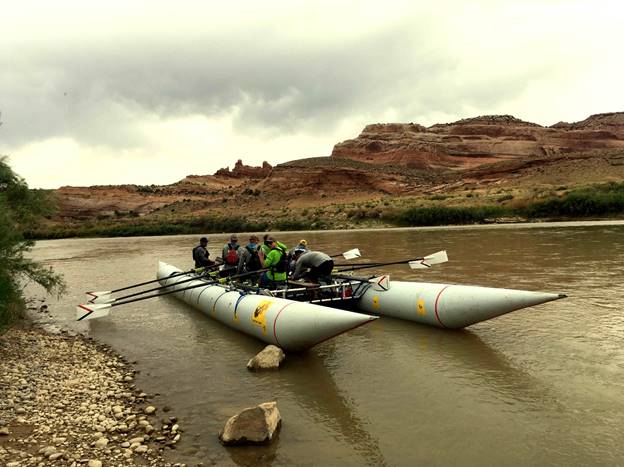
In this test run they used aluminum top rails but did not have extenders on the frame.
Frame modifications were made using light weight carbon Fiber shafts, from Cataract Shaft oar material.
The next run was a dress rehearsal down the bottom part of the Grand Canyon from Diamond Creek down. This is where it was discovered that the tubes and the frame were too flexible especially with the carbon fiber top rails. Top rails of carbon fiber tubing was replaced with Aluminum, extenders were placed out to the ends of the tubes, more cross bars added for cross strength. One seat bearing had broken rendering that seat unusable and so they tripled the number of sliding seat bearings on each sliding seat. In the following picture you can see how much bend the carbon fiber frame members were allowing in the tubes.
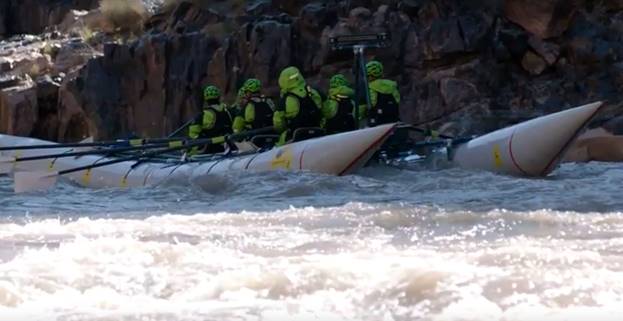
See the amount of curvature that was achieved with the carbon fiber frame members
I went to Lees Ferry to deliver some dry bags, a Paco Pad, and some Tearaid quick patching material. I also wanted to talk to them before they left. This is what I saw when I got there. (A video clip) They were doing slalom turns around the buoys in the channel for practice.
Later we went back to Marble Canyon where I met the camera Crew. They are planning to have a movie out about this project somewhere around Mid-March.
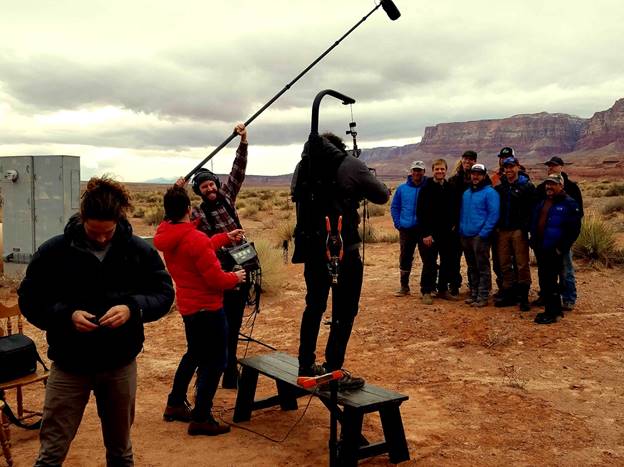
In the morning, the team went through the same talk that every private group gets with the ranger before launch. In order to run the Granite George Mid-day, they would need to leave at around 11pm Friday night, and they were not in a big hurry now.

So I was able to take a short ride on the boat, (video clip) and was very impressed what 4 oarsmen were doing to make this big cat move.
It has a beam of 10 ft., with 6 feet between the tubes for huge sideways stability. It is 40 ft. long total. 6 oar stations, each oarsman uses only 1-12 ft. sculling oar with very large blades. There is a steering oar lock on each end, but most of the time unless the boat does a spin, Steering will be done from the end opposite of the lights.
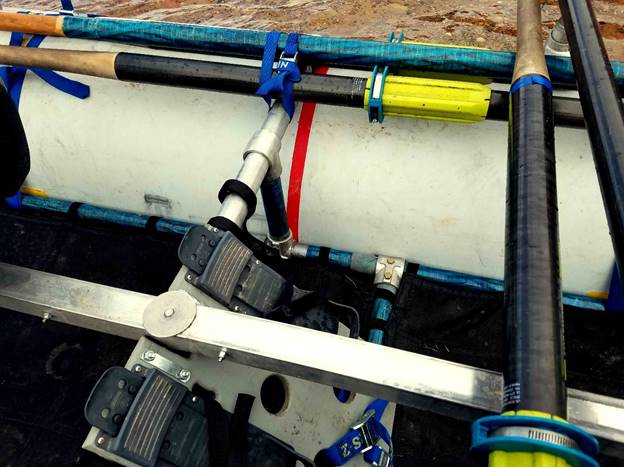
This picture is a detail shot of the foot brace. And the square aluminum tubing used for the sliding seat. It also shows how they used Carbon fiber material, much like cataract shaft oar shafts, to lighten up the bottom part of the frame. It also shows the mesh decking below the frame.
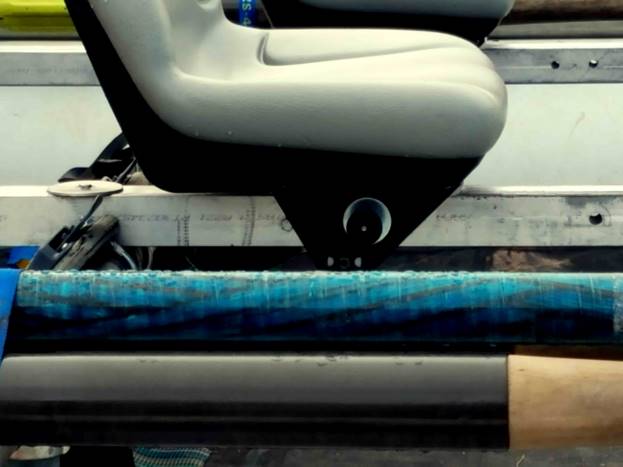
This picture shows the sliding seat and a spring loaded pin that is put in place for running rapids. What is not easy to see, are the extra Bearings on top of the seat mount that ride along the square tubing.
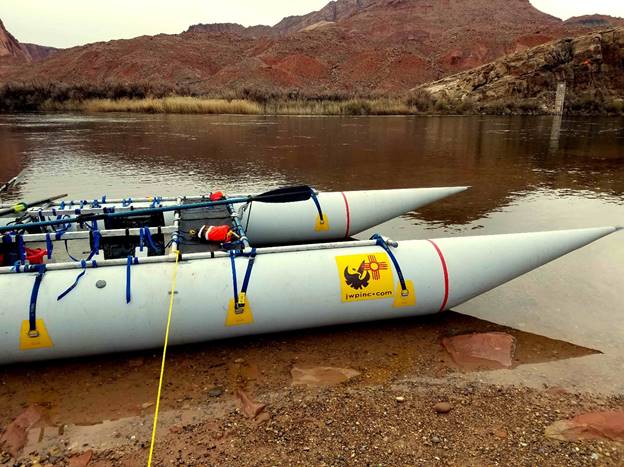
This picture shows the top rails along the top of the tubes, and how they are extended toward the ends of the tube. This will keep a lot of tube flex down, and keep the center of the tube at a lighter draft for less drag.
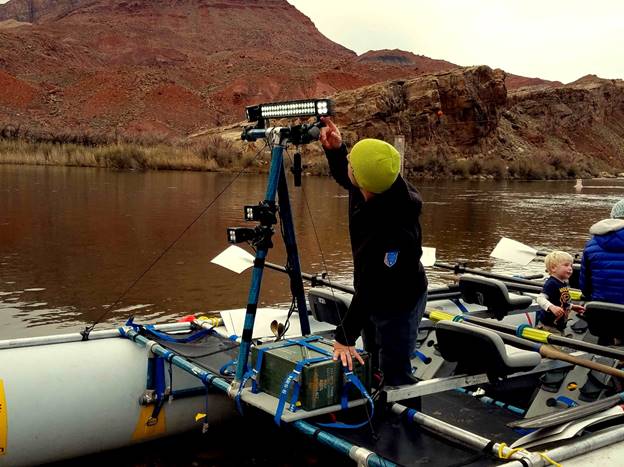
Here Seth is showing me the lighting system, that can shine about 75 yards out front, and with side lights they can see a fairly broad spectrum of the river. The real problem would be fog or heavy rain/snow.
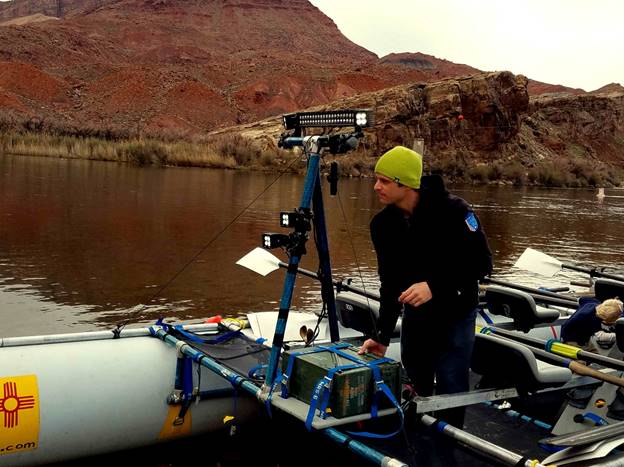
They even thought about how to follow the current “seam” at night with special lights that shine up close so the tiller man can see it.
Well by the time I publish this, we will know if they beat the record or not. The following picture is from marble canyon lodge, and it is a picture of the guys they have to beat. The record held up since 1983. The Emerald Mile is a good read.
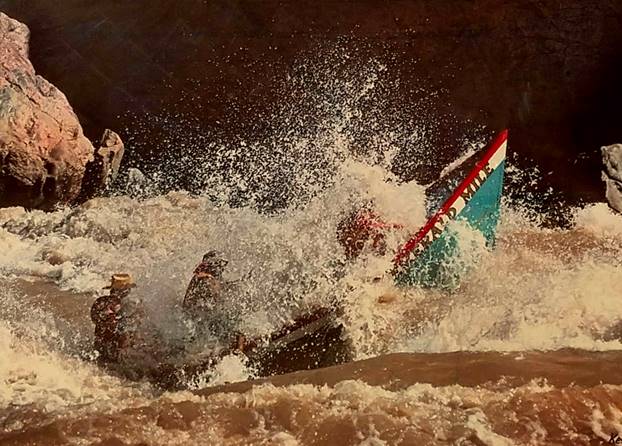
Good luck to our team.
They include: Seth Mason, Marty Borges, John Mark Seeling, Matt Norfleet, Ian Anderson, Kurt Kincel, Jeremiah Williams, and Robbie Prectl.
You all worked so hard to make this happen.
Update after the run
Sunday around Noon I started to get a little anxious about not hearing anything. So I emailed Seth’s Partner at work.
Hey Jack thanks for the email.
For watching a blue dot move down a map every 30 minutes, that was pretty exciting?
From what I understand, they hit something in Lava (either wave or rock, don't know...) that caused one or more of the carbon cross tubes on the frame to snap, which then punctured one of the cat tube compartments.. Being carbon fiber, I can only imagine it was a sharp splintery mess.
We've only got that info based on a few short texts from the InReach locator beacon they had. I imagine more info will come soon.They pulled over onto Tequila Beach and did a tube repair which took 1-2 hrs then continued downstream.They are just coming into Pierce's now from what I can tell.
That was 3 Pm on sunday
Then at 9:02 am on monday I got this email from Seth's other partner Julia,
Hi Jack,
You may have heard by now--everyone is safe and sound and back on dry land, but the tube repair did cause enough of a delay for them to miss the deadline.
But you're right, a worthy journey to be proud of, an epic tale, and a success on many levels.
I know the crew is thankful of your support, and hopefully we can hear more about the adventure when they are all back home.
Cheers,
julia
Here is what Seth had to say about the damage!
That was a hell of an adventure and, as it turns out, Cataract Oar tubing is some pretty bomber stuff. The brake in the frame that punctured the tube was actually on one of the aluminum rails, not the composite. The butt-joint that failed was in the front right corner where the extension bars met the main sections of the frame--the second T-fitting back from the front. I placed that joint on the inside of a T-fitting, but did not anticipate how much flex and torque would be placed on the frame at that location. Early in the first day, possibly in Hance, we hit a big wave and the butt-joint flexed its way forward of the T-fitting. Once it was in this position, the full force of the tube flex was placed on the splice at the butt-joint and not on the stronger T-fitting. The splice failed at that point but the break did not puncture the boat. We lashed things together as best we could with cams, cleaned up the broken splice ends and buried them back inside a T-fitting. We monitored that spot for the rest of the day and it seemed stable. Stable enough for everything but the Mountain Wave, as it turns out. We were elated to make the entry to Lava just as we wanted to. It was completely dark and those waves looked huge. Everything went well until we hit the mountain. The front third of the boat was buried in green water, the frame separated again at the damaged location, and the tube was punctured. The hole was about 4 inches long and the 5 psi rushing out of it sounded like a jet engine. We knew we had to get to shore quickly. By the time we got to the beach, the front right rower was waist deep in water, still pulling on the oar. The rapid patch didn't work. The wind was blowing sand everywhere, it was raining, and that eddy is a bit violent at 19,000 cfs. We abandoned that attempt after a while and mixed some glue and applied a standard patch. That held, but we were nervous enough about it that we put a thick cam around the tube over the patch and ran it at a really low pressure--probably less than 1 psi--until the take out.
The composite frame tubes from Cataract Oars held up really well, especially considering the fact that we straddled a rock on the right side of Crystal that smashed into every composite rail on the bottom of the frame--this was the worst case scenario that we acknowledged could occur but imagined would be unlikely. All but two of the tubes took a substantial enough hit to rupture the tube and splinter the material but they generally maintained their shape and did not fully separate at the location of the damage. It sounded like a series of gunshots when we connected with that rock and we expected the worst. We did a floating repair job with a roll of fiberglass tape and then lashed a paddle to the two most heavily damaged tubes and kept flying downstream. Those pieces made it through Lava and to the end of the run without causing any problems.
After spending 2.5 hours below Lava patching the tube and fixing the frame, it was apparent that we were not going to break the record. Unfortunate because, up to that point, we were maintaining the 8.4 mph speed that we knew we needed to. We ran the bottom of the Canyon much slower and the energy among the team members changed, but everyone had a blast and stayed very positive. Our official time was 39:24.Now we're just trying to catch up on sleep. Between rigging the day before, doing the run, and tearing everything down at the take-out, we were awake for 60 hours. I had no idea the human body could do that, but we're all a bit wrecked. We'll be in touch! Super stoked to have had you guys involved in this project.
One further note from Seth:
Patching in the rain was a challenge. That was a first for me. We ended up boiling water with the Jet Boil and pouring it into a large ziplock bag that was holding our fried chicken tenders. We put the bag of hot water on the patch after we applied the glue and it seemed to really help bond the material.
Here is an article that Marty Borges wrote for the Boatmens Quarterly Review
Article from the Denver Post
The raft was lined up perfectly for the massive rapid.
The Colorado-based team — eight accomplished paddlers on sliding seats atop a 48-foot custom raft designed to fly down the Grand Canyon — was on pace for a record.
Suddenly the boat was vertical. Then it was broken.
“It sounded like a gunshot,” said Ian Anderson.
“Followed by the sound of a jet engine,” said Seth Mason.
In the pitch black of night on the Colorado River’s burly Lava Falls rapid, an aluminum bar had snapped and punctured a 4-inch hole in the inflatable beam of the custom-built craft. The air hissing from the punctured tube wasn’t just the sound of trouble. It signaled the dissipation of a dream to paddle the 277-mile length of the Colorado River’s Grand Canyon in record time.
“It was an exciting couple moments. There was this elation that we had made it through and we had such a clean line and then coming face-to-face with the reality that our boat was sinking,” said Mason, one of seven whitewater athletes who had spent the last year training and designing the speediest raft with a goal of breaking a record set by a kayaker. “It was an emotional roller coaster.”
In the roiling eddy below Lava, the sleep-deprived paddlers — they had been rowing non-stop for more than 20 hours — boiled water to heat a patch. It was dark and raining. The patches weren’t sticking. The tube wouldn’t inflate to the hard pressure needed for speed.
“We really limped out of there,” Mason said of the last nine hours of dejected flatwater paddling below Lava. “We had abandoned the plan and recognized that any dream for a record was gone. At that point, we were aiming to get out alive.”
The six members of the U.S. Whitewater Rafting Team — the Eagle River Valley’s Jeremiah Williams, John Mark Seelig, Robbie Prechtl and Kurt Kincel, Seth Mason of Carbondale and Matt Norfleet of Breckenridge — spent more than a year building this mission. The team before them — the world champion Behind the 8-Ball rafting team — had set a 24-hour record in a similar vessel in 2006, paddling from the Upper Colorado below Gore Canyon to Moab.
The new team talked about a record attempt for years. But it was chatter. When Chaco — a water-friendly sandal company started by a Colorado river guide — asked the team for an idea beyond sponsorship of the team’s rafting races, the talk quickly became action.
Forest Woodward, Special to The Denver Post
The U.S. Whitewater Rafting Team, from left, Kurt Kincel, Seth Mason, Jeremiah Williams, John Mark Seelig, Robbie Prechtel and Matt Norfleet — joined by Ian Anderson in red hat and Marty Borges, far right — pose in Lee’s Ferry before setting off in their custom-made raft last week in an attempt to set a speed record paddling down the 277-mile Grand Canyon.
“As soon as they came on board, the project went from being an abstract notion to much more of a reality,” Mason said.
It was an audacious goal. During a historic flood event in 1983 that saw the Colorado River’s flow below the Glen Canyon Dam reach 72,000 cubic-feet-per-second, a trio of paddlers — Kenton Grua, Rudi Petschek and Steve Reynolds — pushed their wooden dory, the “Emerald Mile,” down the 277-mile stretch of the Grand Canyon in 36 hours and 38 minutes. That record stood untouched until January 2016, when the record fell twice in one week. Aurora CPA Ben Orkin, paddling solo in a fiberglass and carbon fiber race kayak, set the Grand Canyon speed record on Jan. 24, 2016,at 34 hours and two minutes — a speed made more remarkable by the fact that he swam from his boat in Lava. He shaved less than an hour off the time of a team that had set a new speed record two days earlier.
After securing January permits from the National Park Service, the team set about designing a boat that could hold eight paddlers, which included the six-man rafting team, Carbondale endurance athlete Ian Anderson and Grand Canyon veteran Marty Borges, who served as a sort of coxswain, manning a tiller oar on the rear of the boat.
They ripped the sliding mechanisms off of rowing machines and mounted them with lightweight river seats, with the rowers each on an oar and their backs facing downstream. They built an aluminum frame that weighed more than 400 pounds, and tried a carbon-fiber frame on the Colorado River above the Grand Canyon that flexed too much. The design ended up a hybrid of carbon and aluminum.
Related Articles
- January 25, 2016 Denver man completes Grand Canyon river trip in record time
- June 18, 2007 Vail teams on top of worlds
They mounted the frame on two 48-foot tubes made by Jack Kloepfer, whose Jack’s Plastic Welding in Aztec, New Mexico makes virtually indestructible river tools. Kloepfer went out to see the team off from Lees Ferry.
“I was really impressed with the thought they put into that boat. It was a valiant effort,” said Kloepfer. “For me, the record is interesting but the real cool part is that the story is a whole hell of a lot better right now. Nothing bland about that story.”
Last week, they scraped record snowfall off the raft in Carbondale and hit the road for Arizona.
The plan was to average at least 8.3 mph. That means no stopping. No bathroom breaks. No sleeping. A rest spot on the raft allowed for a few minutes off the oar, but taking that spot included manning the spotlight to watch for rocks while pounding water and food.
Anderson said the team’s food supply was like a “traveling aid station,” with a buffet of high-calorie foods: self-heating OMeals, sausage-wrapped hard-boiled eggs made by Mason’s mom, date balls, bacon, M&Ms and chocolate bars. They carried all the necessities of a Grand Canyon river trip — including aportable toilet and a firepan — even though they never planned to leave the boat.
“We congratulated ourselves on how low impact we were,” Mason. “Besides a little carbon-fiber paint on the rock in Crystal, we left no trace we were there.”
The team put on the river at Lees Ferry at 11 p.m. Jan. 13. It was raining, but not windy. The river was rolling at around 20,000 cfs. The plan was to race through the inner gorge’s meatier rapids in daylight and then the easier, yet still daunting rapids, at night. They had an LED light bar mounted on the raft and speakers for tunes.
They greased the first big rapid, Hance, the first true rapid for both the vessel and the team. Spirits were high. Maybe they could make it to Lava before nightfall.
At House Rock rapid, the boat spun sideways through a towering wave train. But it didn’t come close to flipping. Still, the scare prompted a seating switch, where the two paddlers nearest Borges on the tiller oar were facing downstream. Still, the four paddlers at the front of the boat were facing backwards.
“That was pretty significant experience, dropping into whitewater backwards at night,” Anderson said. “It required putting a lot of trust and faith in everyone in the boat.”
The team was skirting the huge rapids of Crystal on the right side when the raft straddled a rock. It smashed all four carbon-fiber bars across the bottom of the frame. They improvised and, while still paddling, strapped back-up oar shafts across the bashed bars.
“It made some really creaky noises but it held for another 150 miles,” Mason said.
They were still on record pace when they arrived at Lava. It was 8:45 p.m. Dark. And really loud. Their line was clean, straight down the middle and well away from the infamous Cheese Grater rock. But the surge in the middle of the rapid — a mountain of water that erupts in unpredictable, boat-flipping bursts — caught them. A union of aluminum to carbon-fiber failed, puncturing a tube.
“I was basically underwater,” said Anderson. “John Mark, next to me, he was nipple deep. We were sinking.”
The 40 miles of flatwater beyond Lava were “absolutely brutal,” Mason said.
One of the tubes was barely inflated and dragged through the water. A strong headwind didn’t help. They had lost a lot of motivation, knowing the record was impossible. Mason fell asleep standing at the tiller and nearly tumbled off the boat. The team rotated through 15-minute catnaps on the rest perch.
They finished in 39 hours and 24 minutes, which includes three hours of repairs below Lava and who knows how much lost time on the final push out. After de-rigging the raft and loading it on a trailer, the team had been awake for more than 60 hours.
“Sleep deprivation was the big enemy,” Mason said.
Still, the team was in a celebratory mood on Sunday. They knew everything had to go perfect for them to beat the time of a racing kayak. The record is reachable, Anderson and Mason said.
And even though they raced down the most beautiful canyon on earth mostly in the dark, there were more than a few memorable moments.
“It was my first run down the canyon and two-thirds of it were at night; most of it facing backward,” Mason said. “It was a unique way to experience a place you hear so much about. But that first morning, with the blue and grays and the sunlight in the rain, that was an amazing way to start a day.”
Another speed Run in 1993 with a motor.
By Tom Martin
A little known Grand Canyon Speed Run was accomplished by John Williams, Clyde Deal and John Weisheit in 1993.
Williams designed, built and owned the boat. The co-pilots were Deal and Weisheit. The trio launched at Lee’s Ferry on Sunday, July 25, 1993, at 5:36 AM local time. Averaging 23 miles an hour, the group was at Elves Chasm about 11:00 that morning, having already changed out the motors propeller.
A little before noon, the boat’s motor struck a rock in Bedrock Rapid. In an interesting twist of fate, one of the team of boaters who held the Colorado River through Grand Canyon Speed Record Crown at the time, Kenton Grua, helped in the repair of William’s crippled boat. The men worked for most of a day to fix the motor, raising the stern of the boat enough to fix the lower unit on the outboard without removing it from the boat's transom. William's and his team passed the Grand Wash Cliffs after 35 hours, 43 minutes and 28 seconds, passing Grua's time of 36 hours 38 minutes.
Matt Kelma took the speed crown from the William's group 23 years later. On January 20, 2016, Kelma paddled a downriver kayak through Grand Canyon to take the Speed Record Crown in a 35 hour, 5 minute traverse. Kelma has the distinction of wearing the Crown for the shortest length of time. Only four days after putting the Crown on, Kelma passed it on to Ben Orkin. Paddling an Epic Sea Kayak, Orkin is the present wearer of the Grand Canyon Speed Record Crown, with a time of 34 hours, 2 minutes, set January 24, 2016.
home | products | pictures & information | find a dealer | river stories & testimonials | related info | FAQ | contact us
Order inquiries: shop.jpwinc@gmail.com
Custom & Prototype inquiries: pschoser.jpwinc@gmail.com
© 2011 Jack's Plastic Welding, Inc
Toll Free 1-800-742-1904
P. 505-334-8748, F. 505-334-1901
